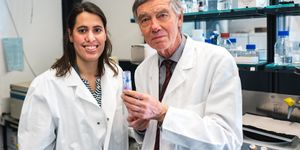Using only a few different cell types from the heart, scientists at York University have created a miniature heart model that actually keeps a beat. The scientists did not have to use scaffolding, which is a common way to string cells together to make miniature, simplified versions of organs that can be used in research. The York U team used a substance called ViaGlue to keep the various cells - contractile cardiac muscle cells, connective tissue cells and vascular cells - stuck together.
"This breakthrough will allow better and earlier drug testing, and potentially eliminate harmful or toxic medications sooner," said York U Chemistry Professor Muhammad Yousaf. He has started a company to commercialize ViaGlue and make it available to others. The research team has also published their work in Nature Scientific Reports.
"Making in vitro 3D cardiac tissue has long presented a challenge to scientists because of the high density of cells and muscularity of the heart," said Dmitry Rogozhnikov, a doctoral student at York U. "For 2D or 3D cardiac tissue to be functional it needs the same high cellular density and the cells must be in contact to facilitate synchronized beating."








